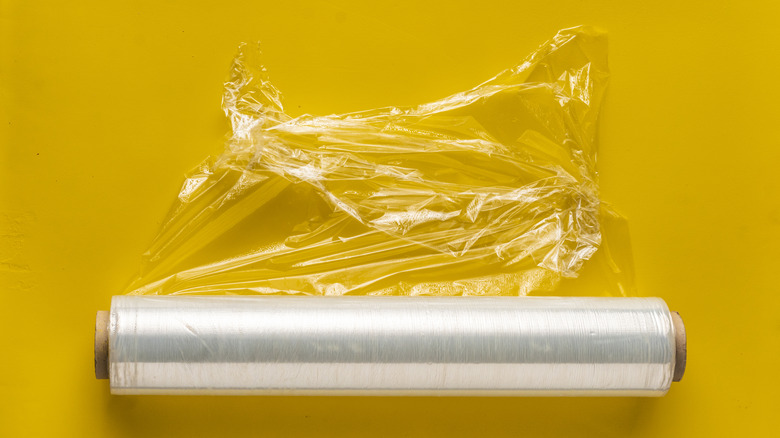The Plastic Wrap Hack For Way Easier Fridge Cleanup
Refrigerator cleaning is one of those chores that only seems to happen during an emergency. When your shelves are lined with everything from leftovers to condiments, a small spill quickly turns into a big problem. You know the scenario: You open the door only to find a rapidly widening pool of leaking soup filling its tray. Before you can grab a paper towel, it drips onto the meal prep and soaks the rest of your produce. You try to limit the damage, but by the time you stop the leak, you've removed half the items in the refrigerator and are wiping down each tray to restore cleanliness.
Luckily, a common kitchen item can help you avoid this nightmare scenario altogether. Before filling your fridge with food, try lining the refrigerator shelves with plastic wrap. This handy barrier will cut down on cleanup time and help keep your fridge tidy, even when it's packed to bursting.
Line the shelves
Before adding the plastic wrap, start by deep cleaning your fridge. You'll have to remove all the contents, but once these barriers are in place, it will save you loads of time when the inevitable spill occurs. Be thorough — any debris left behind will stay trapped under the plastic wrap. Make sure to get all the gunk behind fridge drawers and use a disinfectant. Let the surfaces dry completely before sealing them in plastic.
Once the refrigerator is clean, tightly line each shelf with plastic wrap. Make sure to tuck the plastic over every edge and around all sides. On shelves that require multiple sheets, overlap the edges to prevent liquids from running underneath. The pliability of plastic wrap makes it an ideal material to thoroughly cover each shelf. However, if you don't like working with its (admittedly annoying) clinginess, you can try using wax paper. Wax paper is more opaque and will darken the interior of your refrigerator, but it will also catch spills and mitigate messes. When all surfaces are covered, you can re-pack your refrigerator as normal.
Now, when a container leaks or a sauce spills, you can quickly remove the messy item and simply toss the plastic wrap that was sitting underneath. The thin plastic barrier will prevent any refrigerator-wide catastrophes and keep the mess localized. Eventually, when the plastic wrap collects small stains and crumbs, you can swap it out for a fresh liner without breaking out the heavy-duty cleaning gear.
Another genius use for plastic wrap
Beyond covering shelves and foods, plastic wrap has many clever uses. It can even be used to rescue corked wine. When wine is corked, it means that the cork has begun to rot, releasing 2,4,6-trichloroanisole, or TCA, into the liquid. This introduces a moldy scent to the bottle.
A 2021 study published in the journal Food Chemistry found that the presence of plastic wrap "reduced significantly" the number of TCAs in a spoiled wine without destroying its flavor profile. The study even noted that exposure to plastic wrap raised the "overall fruity aroma" of the wines.
To take advantage of this neat trick, pour the spoiled wine into a decanter or pitcher. Then, wad the plastic film into a ball and add it to the wine. Let the exposed wine mix around the hunk of plastic. After about five minutes, you should notice an improvement in the smell. Eventually, the plastic film should remove most of the musty fragrance from the liquid.


